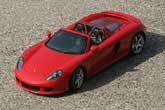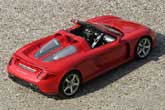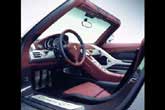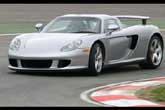Recent Articles
Popular Makes
Body Types
2005 Porsche Carrera GT
Speed, handling and a symphony of 605 horses

FONTANA, Calif. – Hurtling down what seems to the narrowest ribbon of asphalt, the advertisements on the racetrack’s walls reduced to streaks of vivid color in my peripheral vision, my ears fill with the howl of the 2005 Porsche Carrera GT’s big V-10 engine. Porsche pro-racer David Murray is yelling into my helmet radio, telling me to stomp on the throttle. But we’re already well into triple digits and a hard right-hand corner is coming up fast. Instead, I stomp on the brake pedal and the G-force nearly knocks the air out of me. Mid-turn I’m off the brakes, hit the apex and finally obey Murray’s command, stomping on the accelerator pedal exiting the turn. I already feel like a marble expelled from a slingshot, but Murray continues to demand more throttle. Lap after lap, the sleek silver Porsche Carrera GT does not make a miss-step on the road course at the California Speedway near Los Angeles. With the slightest movement of hands and feet this incredible automobile responds instantly to input. It is as though the thing is reading my mind, knowing before I do what will be asked. And, that sweet shriek of an exhaust note playing in my head, the sound track to my exclusive automotive fantasy, is nothing short of intoxicating. Murray is riding shotgun to make sure I extract the most out of my Carrera GT experience and that I return to the pits with the car intact. Both goals are achieved, but it’s easy to see that someone could get in far, far over their heads with this car despite the fact that it’s one of the most forgiving exotic super-cars I have ever driven.
Powertrain
Powertrain Derived from Porsche’s 24 hours of LeMans efforts, the 5.7-liter, double overhead cam V-10 engine generates 605 horsepower and 435 lb.-ft. of torque, transferred to the rear wheels through a six-speed manual transmission. Unofficially, the Porsche Carrera GT is a racecar; however this is a racecar that was built for the street. It isn’t so much because it produces monstrous amounts of power from its V-10 engine – though it does – or that its carbon fiber construction keeps everything very light weight. It’s more the sum of its parts that make this car worth every bit of its $440,000 price tag. Derived from Porsche’s 24 hours of LeMans efforts, the 5.7-liter, double overhead cam V-10 engine generates 605 horsepower and 435 lb.-ft. of torque, transferred to the rear wheels through a six-speed manual transmission. The whole shebang sits just behind the driver in a mid-ship configuration, deep in the belly of the car. Similar to those used in exotic prototype racing machines, the engine is equipped with a dry sump oil system so there is no oil pan like on traditional street cars. This design allows the engine to sit very low – the crankshaft is a few mere inches off the ground – to enhance stability at high speeds. Appearing for the first time in a street car, Porsche’s Ceramic Composite Clutch (PCCC) technology helps swap gears in the Carrera GT. Ceramic composite clutch systems are used in racing cars but often are short lived. To extend durability for street use, Porsche engineers developed a new two-plate design using ceramics containing carbon fiber and silicon carbide, making this clutch both strong and reliable. At just a little over 6.5 inches in diameter, it is half the size of a normal clutch. This compact design also aids in lowering the car’s center of gravity. This new clutch design has a few critics who grouse that its quick release character causes them to stall the engine on take off. Launching the GT really isn’t all that difficult if you follow Porsche engineers’ guidance. Don’t touch the accelerator, ease off the clutch pedal slightly, and then as the car starts to roll, quickly release the clutch and you’re on your way. Remember, however, to be just as subtle with the accelerator. We eased out of the pits and rolled smoothly into the throttle, producing eye-watering acceleration that shoved us back into our seats.

Nuts and Bolts
Nuts and Bolts At the track, the massive 15-inch ventilated discs and six-piston calipers are equal to the Carrera GT’s stunning acceleration in bringing the car to a safe and sure stop. Additionally, they reduce unsprung weight by 50 percent over a conventional disc brake system. Under the Porsche Carrera GT’s beautiful carbon fiber reinforced body lurks a bevy of state-of-art technologies. In addition to the clutch, ceramics compose the Carrera GT’s high-tech braking system. Developed for demanding motorsports applications, Porsche’s ceramic brakes are the first to work well for on-road use. Standard equipment on the Carrera GT, they are optional on other Porsche models. But on the Carrera GT – a car that is capable of 0-to-60 mph in about 3.8 seconds, and reaches 100 mph in less than seven seconds, velocity reduction is critical. At the track, the massive 15-inch ventilated discs and six-piston calipers are equal to the Carrera GT’s stunning acceleration in bringing the car to a safe and sure stop. Additionally, they reduce unsprung weight by 50 percent over a conventional disc brake system. The realized ancillary benefits include enhanced suspension response, better vehicle handling, better fuel efficiency, and improved performance. Like the brakes, the Carrera GT’s chassis and suspension systems are race-bred, based on experience derived from the GT1 racecar that won Le Mans in 1998. So sophisticated is the design of the suspension, the shape of its components actually improves the Carrera GT’s aerodynamics. The stainless steel, pushrod suspension design employs double-track control arms at all four corners refining the response of each wheel to the road. The unique aspect of this fine-tuned suspension system is the advanced manner with which it can soak up road surface irregularities while effectively handling high-speed cornering. Prior to this innovative system, a racing car suspension would nearly beat you up by its firm handling. Surprisingly, the Porsche Carrera GT is a vehicle you could drive all day long. Under the Porsche Carrera GT is a full-length underfloor that was carefully developed in the wind tunnel to not only improve air flow and engine cooling, but also assist in maintaining the Carrera GT’s front-to-rear downforce balance. With this attention to detail Porsche has developed an automobile that not only looks fantastic but also exhibits outstanding performance.

Features
Features Cool features abound, such as the rear wing that spans across the rear deck from fender to fender, automatically rising into optimum position as the GT reaches 75 mph and increasing downforce by 30 percent. New for the 2005 model year, Porsche has added minor updates to make the Carrera GT a little more street friendly. A glass screen is now mounted between the supplemental safety bar hoops (we can’t call them true roll bars). The seats get a height adjustment along with additional bolstering in the thigh area. Adding to the exclusive aura is a magnesium cover mounted on the center console and emblazoned with the car’s individual chassis number. A built-in trickle charger was also added to assist in keeping the battery juiced since there are electronics in the Carrera GT that sip power when the engine isn’t running. Cool features abound, such as the rear wing that spans across the rear deck from fender to fender, automatically rising into optimum position as the GT reaches 75 mph. As with every other element of this Porsche, nothing is done without a purpose. The rear wing increases downforce by 30 percent. Making the Carrera GT an all weather car are two removable roof panels that store in the limited trunk area. Driving this car in foul weather would seem insanity, and we are confident that not many Carrera GTs will ever see a drop of rain.

Wrap-up
Wrap-up We blasted through the S-curves as if they were straight. The up shifts and down shifts were smooth and sure through the short-throw shifter. Surroundings flashed by in a greater flurry of colors than ever. With each lap of the California Speedway’s road course, I could see that the Porsche Carrera GT is everything an enthusiast dreams of, and more. With pro-driver Murray’s encouragement and his knowledge of the track – he raced there just a week before my test drive – in very short order we lapped the track as if dancing, the car and driver working in concert as one. Any apprehension I felt during the preliminary laps was gone. Using as much of the car’s abilities as I dared, still Murray encouraged me to push just a little further. I didn’t hesitate; the car had shown it can respond and Murray, obviously comfortable with my abilities, allowed the Carrera GT and I to have our rein and run free. We blasted through the S-curves as if they were straight. The up shifts and down shifts were smooth and sure through the short-throw shifter. Surroundings flashed by in a greater flurry of colors than ever. Sneaking a glimpse at the speedometer, I saw the needle way up in the high 100s, yet it felt as though we were cruising down a freeway at the posted speed limit. To say that putting the Carrera GT through turn after turn is a thrill could be taken as hyperbole. After hours and miles behind the wheels of untold numbers of high performance automobiles, each with their quirks and idiosyncrasies, I can count on one hand the vehicles that can compete with the Carrera GT in delivering fascinating good looks, astounding performance, and unflappable abilities on the race track. Far fewer are also as comfortable on a country road or a city street. With grace and confidence, the Porsche Carrera GT is one exotic that can do it all.

Specifications
Specifications With 605 horsepower charged with motivating just over 3,000 pounds, it doesn’t take a doctoral graduate from Harvard to guess that the Porsche Carrera GT is a rocketship. Test Vehicle: 2005 Porsche Carrera GT Price of Test Vehicle: $440,000 Engine Size and Type: 5.7-liter V-10 Engine Horsepower: 605 at 8,000 rpm Engine Torque: 435 lb.-ft. at 5,750 rpm Transmission: Six-speed manual Curb weight, lbs.: 3,043 lbs. 0-60 mph acceleration (mfg.): 3.8 seconds Quarter-mile trap time (mfg.): 11.4 seconds EPA Fuel Economy (city/highway): 10/16 Length: 181.6 inches Width: 75.6 inches Wheelbase: 107.5 inches Height: 45.9 inches Max. Seating Capacity: 2 Max. Cargo Volume: 2.2 cubic feet Competitors: Aston Martin V-12 Vanquish, Ferrari 575 GTC, Lamborghini Murcielago, Maserati MC12, Mercedes-Benz McLaren SLR, Saleen S7
Photos courtesy of Porsche cars North America
